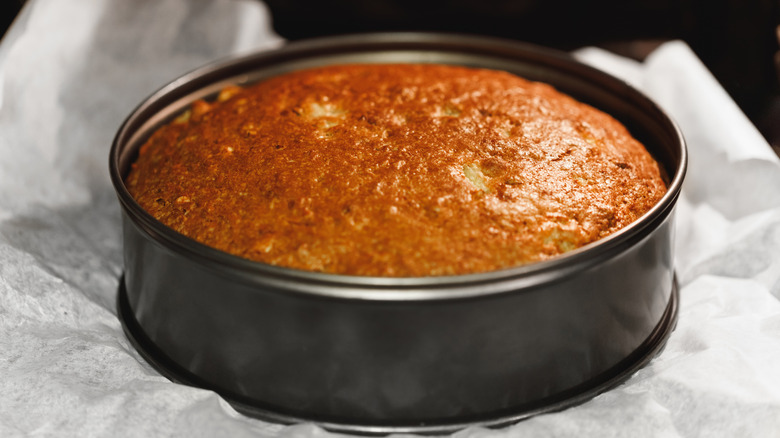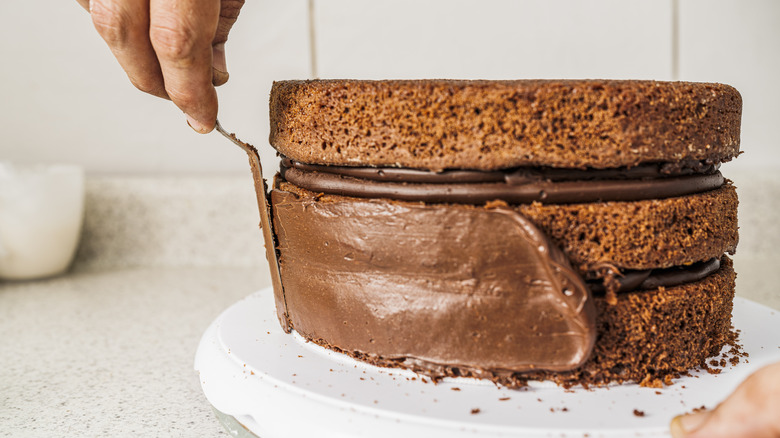When Should You Remove Cake From The Pan?
The difference between a good cake recipe and a great one is all in the details. A perfect Chocolate Soufflé Cake can go from perfectly puffy to battered and burnt in a matter of minutes if you're not careful.
A good chef knows that to set yourself up for success in the kitchen, you should have your "mise en place" ready before you do any cooking. Mise en place is a French term for having all your ingredients together and translates to "setting in place," (per Merriam-Webster). When you're baking a cake, according to Southern Living, this means you should have all your eggs cracked, butter softened, cake pans greased, and so on. The more prepared you are, the smoother your experience will go.
Take that preparation a step further and read over your recipe a few times to make sure you didn't miss anything and to get the timing right. There's often a lot more cooking to a cake recipe than just baking in the oven — for example, meringues need whipping, and butter needs browning. Plus, each pan bakes at a different rate (per Food Network). Make sure your recipe includes directions from beginning to end, including cooling time, so you don't go through all the work of baking a beautiful bundt and then foul it up in the home stretch by trying to get it out of the pan too soon. But if your recipe is lacking, here's how to know when it's time to de-pan the goods.
Beat the heat
You might have heard something about getting cakes out of the pan quickly to prevent overbaking the cake and leaving it dry. Carryover cooking, as explained by Cooks Illustrated, is when your cake (or steak, or chicken) continues to cook even after it comes out of the oven. Because the cake pan conducts the heat, your cake will, indeed, continue to increase in temperature for a few minutes out of the oven. This is no reason to take your cake out of the pan before it's time, however. If your cake recipe is well written, it will tell you to remove your cake at just the right time so that it is cooked through, and also account for a little carryover heat in the pan. This is usually when you can insert a toothpick in the center of the cake and it pulls out clean. Some professional bakers prefer to bake cakes to temperature these days, which you can do at home too – King Arthur Baking Company advises that the temperature range of a baked cake is between 200 to 210 degrees Fahreniheit.
When the cake first comes out of the oven, it's cooked through but the hot "crumb" — the mass of the cake — is delicate. If you try to get it out of the pan too soon it can stick to the pan, break, or both. For most cakes, allow around 20 to 30 minutes at room temperature for cooling (per MasterClass).
Cool and frost
If you're in a rush to get to the good part, the eating, speed up the cooling process up by popping the cake in the refrigerator. Once the cake is cool to the touch you can attempt to take it out of the pan.
If the edges are stuck to the sides of the pan, slide a sharp knife all the way around the perimeter of the cake, making sure the knife touches the bottom. Martha Stewart says this is especially helpful with bundt cakes as they have a lot of nooks and crannies that can stick. Next, place a plate or platter on top of the cake pan and flip it over. If you did your mise en place properly and greased the pans thoroughly, your cake should slide right out. If not, don't panic. Give the pan a couple of hard taps on the bottom, and if that still doesn't dislodge it, do a little finessing with a small spatula.
Once you have the cake out of the pan, it's not quite ready for frosting. The next step is to cool it a little bit longer, as Betty Crocker explains that because your cake is still fragile, and the frosting can pull and tear. Also, any lingering warmth inside the cake will melt the frosting. If you don't want to lose any cream cheese frosting, let your cake cool on a wire rack for another two or three hours before slathering on the sweet stuff.


